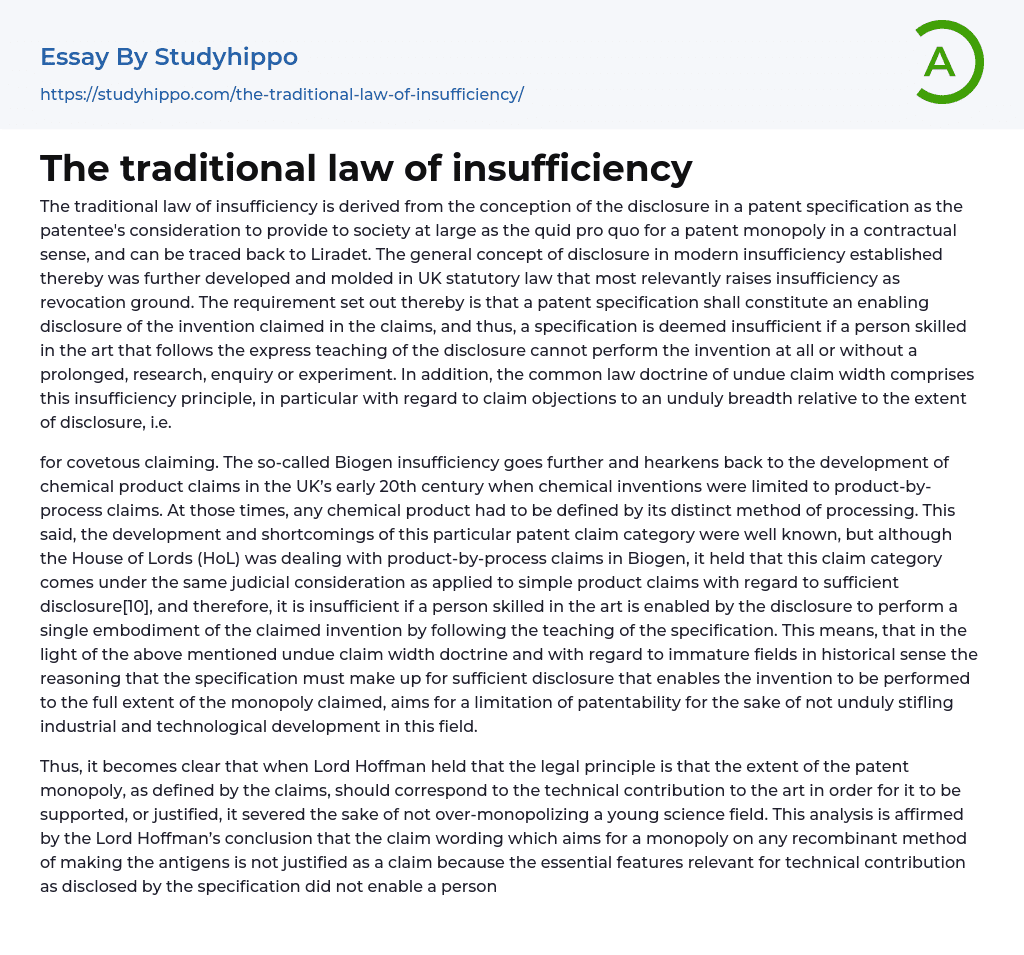The concept of the traditional law of insufficiency can be traced back to Liradet and is based on the idea that a patent specification serves as a way for the patentee to provide society with something in return for a patent monopoly, according to a contractual understanding. The modern understanding of insufficiency, which is centered around disclosure, was further developed by UK statutory law. In this regard, UK statutory law identifies insufficiency as grounds for revocation and requires that a patent specification provides enough information for a person skilled in the art to perform the claimed invention. If a specification does not meet this requirement and does not allow someone to carry out the described invention without extensive research or experimentation, it will be considered insufficient.
The doctrine of undue claim width in common law includes the insufficienc
...y principle, specifically relating to claims that are too broad compared to the disclosure provided. This is known as covetous claiming. The concept of insufficiency, as seen in the Biogen case, has its roots in the early 20th century when chemical product claims were limited to product-by-process claims. During this time, a chemical product had to be defined by the specific method used to process it. The limitations and issues with this type of claim were well-known. However, in the Biogen case, the House of Lords (HoL) determined that product-by-process claims should be treated similarly to simple product claims in terms of sufficient disclosure. Therefore, a claim is considered insufficient if a person skilled in the art cannot perform a single embodiment of the claimed invention based on the information provided in the specification.In summary, considering the aforementioned unjustifie
claim width doctrine and the incomplete development of certain historical fields, the argument states that a patent specification should include enough information to fully perform the claimed invention. This aims to restrict patent eligibility in order to avoid hindering industrial and technological progress in this specific area.
The text highlights the legal principle established by Lord Hoffman which states that the extent of a patent monopoly, as defined by the claims, should correspond to the technical contribution to the art in order to avoid over-monopolizing a young science field. Lord Hoffman concluded that claiming a monopoly on any recombinant method of making antigens is not justified because the essential features disclosed in the specification do not enable a skilled person in the art to achieve the scope of invention. This analysis resonates with the HoL's ruling in Biogen, which introduces a new principle of insufficiency that applies to all types of claimed inventions and their disclosure in the specification. However, this unified rule has faced criticism.Lundbeck renounced their previous stance due to the Biogen insufficiency. Lord Hoffmann disagreed with his colleague, Kitchen J., as he believed that the Biogen insufficiency only applies to product-by-process claims. He argued that the relevant technical contribution should be attributed to the method, not the product itself. Lord Hoffmann acknowledged that even if only one method is disclosed in the patent specification, simple product claims are not affected by the Biogen insufficiency.
Furthermore, Lord Hoffmann clarified that the Biogen insufficiency does not necessarily imply that simple product claims must also support all methods of creating the product, according to the respective statutory provisions and EPC statues mentioned earlier. In the Conor
Medsystems case, it was affirmed that the concept of 'sufficiency disclosure' is linked to the invention itself as defined in the claims. Therefore, when determining the inventive step, only the invention defined in the claims needs to be considered, not the disclosure in the patent specification. As a result, there is still room for debate regarding the interpretation of the scope of invention. In other words, during times of industrialization or technological advancements, such as contemporary biotech, disclosure serves not only to limit the inventor's monopoly right outlined in the patent claims but also to facilitate technology transfer and knowledge diffusion.
- Jurisprudence essays
- Social Injustice essays
- Juvenile Justice essays
- Agreement essays
- Business Law essays
- Common Law essays
- Community Policing essays
- Constitution essays
- Consumer Protection essays
- Contract essays
- Contract Law essays
- Copyright Infringement essays
- Court essays
- Crime essays
- Criminal Law essays
- Employment Law essays
- Family Law essays
- Injustice essays
- Judge essays
- Jury essays
- Justice essays
- Lawsuit essays
- Lawyer essays
- Marijuana Legalization essays
- Ownership essays
- Police essays
- Property essays
- Protection essays
- Security essays
- Tort Law essays
- Treaty essays
- United States Constitution essays
- War on Drugs essays




